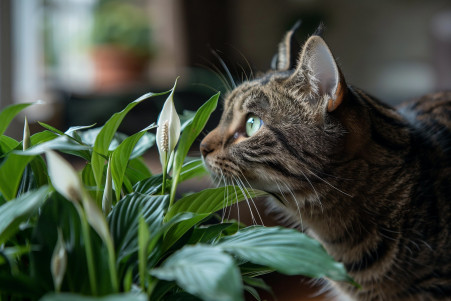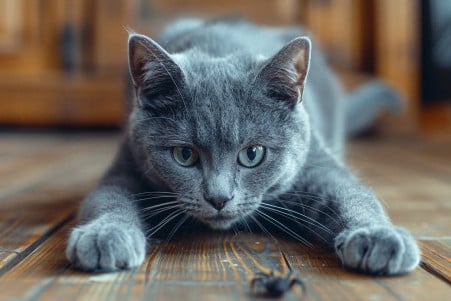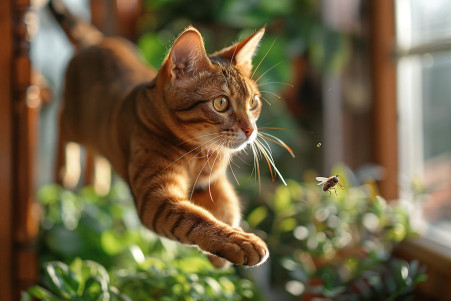Can Ladybugs Hurt Cats? What Science Says
12 June 2024 • Updated 10 June 2024

Ladybugs are not harmful to humans or pets, but their bright colors can be a warning sign to predators - which leads to the question of whether they can be harmful if your cat eats one. Ladybugs secrete a toxic fluid from their leg joints that can cause drooling, vomiting, and irritation in cats. Yet, unless your cat eats a large number of ladybugs, they are not poisonous or deadly to cats and the symptoms are not serious.
We'll explore the scientific evidence from animal toxicology and veterinary medicine to find out what happens when cats eat ladybugs. By explaining which species are actually dangerous and which are just a nuisance, you'll leave with the information you need to keep your cat safe while enjoying these helpful insects in your yard.
Are ladybugs poisonous to cats?
How to Tell Ladybugs Apart and Understand Their Dangers
While the domestic ladybug is a common garden visitor, it is the Asian lady beetle (Harmonia axyridis) that invades homes in the fall to hibernate, leading to more opportunities for cats to come into contact with them. As Senior Cat Wellness notes, the toxicity of ladybugs is species-specific.
The most toxic ladybugs that cat owners should be aware of are the orange ladybug, 2-spot (red) ladybug, pine (black) ladybug, 14-spot (yellow) ladybug, and larch (brown) ladybug. While Asian lady beetles can bite and their bites can be painful, most ladybug species are not poisonous to cats, although they can lead to oral irritation, vomiting, and gastrointestinal upset if they are eaten in large amounts. It is important to be able to tell the difference between the relatively harmless domestic ladybugs and the more dangerous invasive species to help protect cats from accidental poisoning.
Signs and Side Effects of Ladybug Poisoning in Cats
Cats can exhibit a variety of signs after eating ladybugs, including drooling, vomiting, and gastrointestinal upset. The Animal Poison Control Center cited by JustAnswer explains that the bad taste and odor of the ladybug's defensive secretions are usually enough to deter cats.
However, a study cited by Mallard Creek Animal Hospital showed that eating a large number of the more toxic Asian lady beetle species can cause more serious side effects like oral ulcers or trauma. Although Healthline says that ladybug poisoning in pets is uncommon, it's important for pet parents to watch their cats for signs of poisoning if they suspect their cat has eaten a ladybug and to get them medical help if they notice any concerning symptoms.
Thankfully, the JustAnswer article says that most cats will avoid ladybugs after trying one. However, it's still important to know the potential dangers and take steps to keep ladybugs away from your cat.
How to Avoid Ladybug Infestations and Keep Cats Safe
One of the best ways to avoid ladybug infestations and keep cats safe is to make sure that any cracks, holes, or gaps in the home’s exterior are sealed. This will help prevent ladybugs from getting into the house during their overwintering period. Prevention Magazine notes that this is one of the safest and most effective ways to control ladybug infestations.
Healthline also suggests using natural repellents such as diatomaceous earth, citrus oils, mums, cloves, bay leaves, and lavender to deter ladybugs from coming into the home. Window screens and light traps can also help keep ladybugs out. However, the EPA warns against using insecticides indoors as they can negatively impact the health of pets and people.
It’s also important to make sure that cats are kept away from areas where ladybugs are present and to remove any ladybugs that are found in the home as soon as possible. These steps can help cat owners ensure that their pets are safe and that they don’t accidentally eat any of these potentially irritating bugs.
What to Do If Your Cat Eats Ladybugs
If your cat has eaten ladybugs, the first thing you should do is keep a close eye on your pet for any signs of distress or sickness. Catster explains that symptoms to watch out for include drooling, vomiting, and gastrointestinal problems. You should also make sure to get rid of any ladybugs that are still in your cat's environment to prevent further consumption.
Hepper recommends making sure your cat is drinking enough water and looking out for signs of dehydration or other issues. While most cases of ladybug consumption are not life-threatening, JustAnswer warns that it's still important to be careful and contact your veterinarian if your cat shows any signs of concern.
The best thing you can do is to take a preventative approach to ladybug infestations and make sure your cat isn't able to come into contact with these insects in the first place. By making sure to seal any openings and using natural repellents, you can make it less likely that your cat will eat ladybugs. This will help you make sure that your cat is safe while still allowing you to take advantage of the environmental benefits ladybugs offer.
What Ladybugs Do in the Wild and How They Can Help
Ladybugs are a prime example of a beneficial insect that helps keep the ecosystem in balance by eating other insects, such as aphids. Per Hare Today, ladybugs and other insects are also very nutritious, offering high amounts of protein, fat, and the essential amino acid taurine. While ladybugs aren't a good choice for a cat's diet, their presence in gardens and other outdoor spaces can help keep pest populations in check.
That said, as The Spruce Pets points out, the hard exoskeletons of ladybugs can lead to oral and gastrointestinal issues in cats. This is a good reminder to find a healthy balance between understanding the important role ladybugs play in the ecosystem and making sure your pets are safe. We hope this encourages readers to look into the importance of biodiversity and the ways insects help keep ecosystems healthy.
Conclusion: How to Keep Cats Safe While Enjoying Ladybugs
While ladybugs are generally not poisonous to cats, some species and large quantities can cause adverse reactions. It's important to identify and avoid the more toxic ladybug varieties, such as the orange, 2-spot, and Asian lady beetles. Taking preventative measures to keep ladybugs out of the home is crucial for ensuring your cat's safety.
As cat owners, it's important to be vigilant in monitoring your feline friends for signs of ladybug ingestion and to seek veterinary advice if necessary. At the same time, it's important to appreciate the ecological benefits that ladybugs provide by preying on garden pests and maintaining a healthy ecosystem.
By striking a balance between protecting your cat and respecting the role of ladybugs in nature, you can enjoy the presence of these beneficial insects while keeping your furry companion safe. Responsible pet ownership and maintaining a balanced environment are key to ensuring the well-being of both cats and the wider ecosystem.


